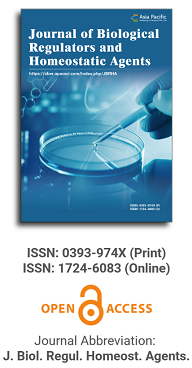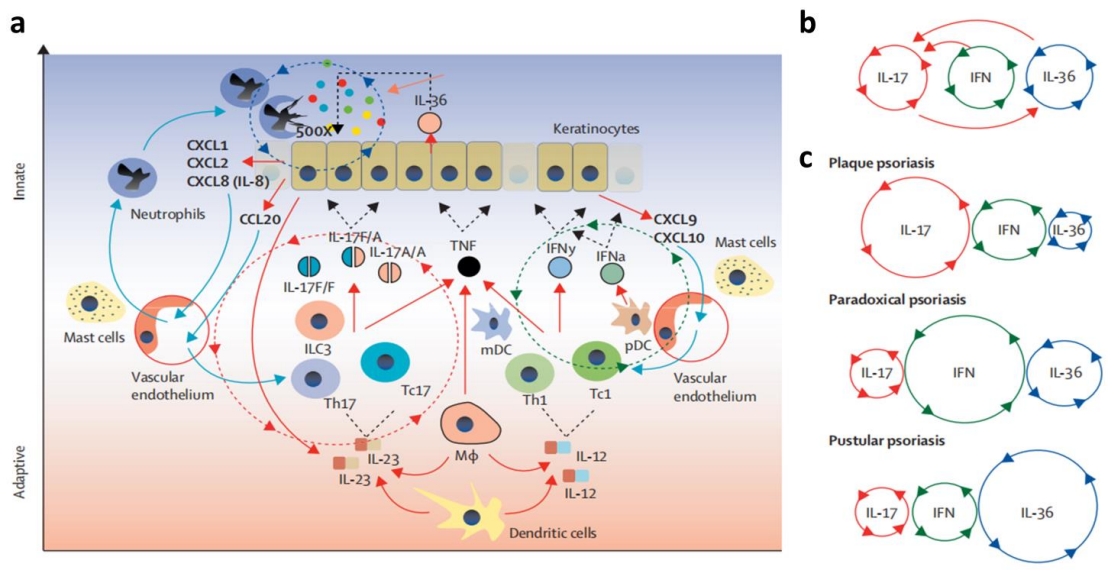
Asia Pacific Academy of Science Pte. Ltd. (APACSCI) specializes in international journal publishing. APACSCI adopts the open access publishing model and provides an important communication bridge for academic groups whose interest fields include engineering, technology, medicine, computer, mathematics, agriculture and forestry, and environment.

Transcriptome analysis of ovaries in mice with premature ovarian failure after treatment with Zishen Yutai pills
Vol 39, Issue 3, 2025
Download PDF Download PDF Download PDF Download PDF
Abstract
Premature ovarian failure (POF) is a critical cause of female infertility, influencing not only reproduction but also life quality. Among the many treatments of POF, hormone replacement therapy is the most commonly adopted. However, it increases the risk of gynecologic tumour formation as well as the severity of cardiovascular and cerebrovascular disorders. Zishenyutai Pill (ZSYTP) is a traditional Chinese patent medication that has been widely used to treat infertility in China, while its underlying mechanism and therapeutic targets on POF remains unknown. To investigate this, we used 4-vinylcyclohexene diepoxide to build POF mouse model, and treated with ZSYTP. Ovaries were collected for histopathological observation, apoptosis assessment and RNA-seq analysis. Results showed that ZSYTP treatment not only decreased atretic follicles, but also increased primary and secondary follicles. In comparison to Model group, ZSYTP group had a significantly lower apoptotic index. Analysis based on differentially expressed genes (DEGs) between Normal and Model group revealed that the immunological response, cell-cell adhesion, and phagosome pathways were most closely associated with the development of POF, while the employment of ZSYTP could ameliorate them. RT-qPCR demonstrated that ZSYTP treatment downregulated the expression of H2-Ab1, H2-Eb1, and H2-Aa, which play multiple and vital roles in immune response. In conclusion, ZSYTP can alleviate ovarian damage of POF mice possibly by downregulating immune response, cell-cell adhesion, and phagocytic pathways.
Keywords
References
1. Nash Z, Davies M. Premature ovarian insufficiency. BMJ; 2024. doi: 10.1136/bmj-2023-077469
2. Panay N, Anderson RA, Bennie A, et al. Evidence-based guideline: premature ovarian insufficiency. Human Reproduction Open. 2024; 2024(4): hoae065. doi: 10.1093/hropen/hoae065
3. Coulam CB, Adamson SC, Annegers JF. Incidence of premature ovarian failure. Obstet Gynecol. 1986; 67(4): 604-606.
4. Sheikhansari G, Aghebati-Maleki L, Nouri M, et al. Current approaches for the treatment of premature ovarian failure with stem cell therapy. Biomedicine & Pharmacotherapy. 2018; 102: 254-262. doi: 10.1016/j.biopha.2018.03.056
5. Wang Y, Jiang J, Zhang J, et al. Research progress on the etiology and treatment of premature ovarian insufficiency. Biomedicine Hub. 2023; 8(1): 97-107. doi: 10.1159/000535508
6. Armeni E, Paschou SA, Goulis DG, et al. Hormone therapy regimens for managing the menopause and premature ovarian insufficiency. Best Practice & Research Clinical Endocrinology & Metabolism. 2021; 35(6): 101561. doi: 10.1016/j.beem.2021.101561
7. Rozenberg S, Di Pietrantonio V, Vandromme J, et al. Menopausal hormone therapy and breast cancer risk. Best Practice & Research Clinical Endocrinology & Metabolism. 2021; 35(6): 101577. doi: 10.1016/j.beem.2021.101577
8. Fournier A, Cairat M, Severi G, et al. Use of menopausal hormone therapy and ovarian cancer risk in a French cohort study. JNCI: Journal of the National Cancer Institute. 2023; 115(6): 671-679. doi: 10.1093/jnci/djad035
9. Zhang B, Liu J. Clinical research and treatment progress of premature ovarian failure in traditional Chinese and western medicine (Chinese). Modern Journal of Integrated Traditional Chinese and Western Medicine. 2020; 29(32): 3543-648. doi: 10.3969/j.issn.1008-8849.2020.32.025
10. Yahyavi Y, Kheradi N, Karimi A, et al. Novel advances in cell-free therapy for premature ovarian failure (POF): A comprehensive review. Advanced Pharmaceutical Bulletin. 2024; 14(3): 543-557. doi: 10.34172/apb.2024.059
11. Zhang L, Mao B, Zhao X, et al. Translation regulatory long non-coding RNA 1 (TRERNA1) sponges microRNA-23a to suppress granulosa cell apoptosis in premature ovarian failure. Bioengineered. 2022; 13(2): 2173-2180. doi: 10.1080/21655979.2021.2023802
12. Fu YX, Ji J, Shan F, et al. Human mesenchymal stem cell treatment of premature ovarian failure: New challenges and opportunities. Stem Cell Research & Therapy. 2021; 12(1). doi: 10.1186/s13287-021-02212-0
13. Yi Y, Ma F, Jiao Y, et al. Comparative efficacy of acupuncture therapies in premature ovarian failure: A systematic review and network meta-analysis. Complementary Therapies in Medicine. 2025; 89: 103141. doi: 10.1016/j.ctim.2025.103141
14. He Q, Wan S, Jiang M, et al. Exploring the therapeutic potential of tonic Chinese herbal medicine for gynecological disorders: An updated review. Journal of Ethnopharmacology. 2024; 329: 118144. doi: 10.1016/j.jep.2024.118144
15. Pang Z, Liang J, Zhong X, et al. The clinical research on Zishen Yutai Pill in the treatment of diminished ovarian reserve for 300 cases (Chinese). Chinese Medicine Modern Distance Education of China. 2017; 15(24): 43-5. doi:10.3969/j.issn.1672-2779.2017.24.019
16. Chen J, Wang N, Peng Z, et al. Zishen Yutai pill ameliorates ovarian reserve by mediating PI3K-Akt pathway and apoptosis level in ovary. Journal of Ovarian Research. 2025; 18(1). doi: 10.1186/s13048-025-01643-0
17. Mang X, Cui H, Zhang F. Effect of Zishen Yutai pill on ovarian reserve function and pregnancy outcome in infertile patients (Chinese). Shaanxi Journal of Traditional Chinese Medicine. 2019; 40(02): 198-200. doi: 10.3969/j.issn.1000-7369.2019.02.017
18. Li Y, He R, Qin X, et al. Transcriptome analysis during 4-vinylcyclohexene diepoxide exposure-induced premature ovarian insufficiency in mice. PeerJ. 2024; 12: e17251. doi: 10.7717/peerj.17251
19. Tran DN, Jung EM, Yoo YM, et al. Depletion of follicles accelerated by combined exposure to phthalates and 4-vinylcyclohexene diepoxide, leading to premature ovarian failure in rats. Reproductive Toxicology. 2018; 80: 60-67. doi: 10.1016/j.reprotox.2018.06.071
20. Sen Halicioglu B, Saadat KASM, Tuglu MI. The relationship of 4‐vinylcyclohexene diepoxide toxicity with cell death, oxidative stress, and gap junctions in female rat ovaries. Reproductive Medicine and Biology. 2021; 20(4): 543-553. doi: 10.1002/rmb2.12398
21. Cao LB, Leung CK, Law PWN, et al. Systemic changes in a mouse model of VCD-induced premature ovarian failure. Life Sciences. 2020; 262: 118543. doi: 10.1016/j.lfs.2020.118543
22. Kappeler CJ, Hoyer PB. 4-vinylcyclohexene diepoxide: a model chemical for ovotoxicity. Systems Biology in Reproductive Medicine. 2012; 58(1): 57-62. doi: 10.3109/19396368.2011.648820
23. Hu X, Christian PJ, Thompson KE, et al. Apoptosis induced in Rats by 4-Vinylcyclohexene diepoxide is associated with activation of the Caspase Cascades1. Biology of Reproduction. 2001; 65(1): 87-93. doi: 10.1095/biolreprod65.1.87
24. Song W, Qiu YT, Li XZ, et al. 4-vinylcyclohexene diepoxide induces apoptosis by excessive reactive oxygen species and DNA damage in human ovarian granulosa cells. Toxicology in Vitro. 2023; 91: 105613. doi: 10.1016/j.tiv.2023.105613
25. Fernandez SM, Keating AF, Christian PJ, et al. Involvement of the KIT/KITL signaling pathway in 4-Vinylcyclohexene diepoxide-induced ovarian follicle loss in Rats1. Biology of Reproduction. 2008; 79(2): 318-327. doi: 10.1095/biolreprod.108.067744
26. Song Z, Song K, Zhao H, et al. Network analysis and experimental approach to investigate the potential therapeutic mechanism of zishen yutai pills on premature ovarian insufficiency. Heliyon. 2023; 9(9): e20025. doi: 10.1016/j.heliyon.2023.e20025
27. Kim D, Paggi JM, Park C, et al. Graph-based genome alignment and genotyping with HISAT2 and HISAT-genotype. Nature Biotechnology. 2019; 37(8): 907-915. doi: 10.1038/s41587-019-0201-4
28. Love MI, Huber W, Anders S. Moderated estimation of fold change and dispersion for RNA-seq data with DESeq2. Genome Biology. 2014; 15(12). doi: 10.1186/s13059-014-0550-8
29. Sherman BT, Hao M, Qiu J, et al. DAVID: a web server for functional enrichment analysis and functional annotation of gene lists (2021 update). Nucleic Acids Research. 2022; 50(W1): W216-W221. doi: 10.1093/nar/gkac194
30. Asadi M, Taghizadeh S, Kaviani E, et al. Caspase‐3: Structure, function, and biotechnological aspects. Biotechnology and Applied Biochemistry. 2021; 69(4): 1633-1645. doi: 10.1002/bab.2233
31. Takai Y, Canning J, Perez GI, et al. Bax, Caspase-2, and Caspase-3 Are Required for Ovarian Follicle Loss Caused by 4-Vinylcyclohexene Diepoxide Exposure of Female Mice in Vivo. Endocrinology. 2003; 144(1): 69-74. doi: 10.1210/en.2002-220814
32. Zhang Y, Yan W, Ge PF, et al. Study on prevention effect of Zishen Yutai pill combined with progesterone for threatened abortion in rats. Asian Pacific Journal of Tropical Medicine. 2016; 9(6): 577-581. doi: 10.1016/j.apjtm.2016.04.002
33. Maharajan K, Xia Q, Duan X, et al. Therapeutic importance of Zishen Yutai Pill on the female reproductive health: A review. Journal of Ethnopharmacology. 2021; 281: 114523. doi: 10.1016/j.jep.2021.114523
34. Xie J, Chen M. Clinical effect of Zishen Yutai Pill combined with climen on premature ovarian failure (Chinese). Journal of Hunan University of Chinese Medicine. 2017; 37(12): 1396-1399. doi: 10.3969/j.issn.1674-070X.2017.12.023
35. Ma L, Lu H, Chen R, et al. Identification of key genes and potential new biomarkers for ovarian aging: A study based on rna-sequencing data. Frontiers in Genetics. 2020; 11. doi: 10.3389/fgene.2020.590660
36. Zhang C, Yu D, Mei Y, et al. Single-cell RNA sequencing of peripheral blood reveals immune cell dysfunction in premature ovarian insufficiency. Frontiers in Endocrinology. 2023; 14. doi: 10.3389/fendo.2023.1129657
37. McGeachy MJ, Cua DJ, Gaffen SL. The IL-17 family of cytokines in health and disease. Immunity. 2019; 50(4): 892-906. doi: 10.1016/j.immuni.2019.03.021
38. Mills KHG. IL-17 and IL-17-producing cells in protection versus pathology. Nature Reviews Immunology. 2022; 23(1): 38-54. doi: 10.1038/s41577-022-00746-9
39. Zhong Z, Su G, Kijlstra A, et al. Activation of the interleukin-23/interleukin-17 signalling pathway in autoinflammatory and autoimmune uveitis. Progress in Retinal and Eye Research. 2021; 80: 100866. doi: 10.1016/j.preteyeres.2020.100866
40. Kunicki M, Rzewuska N, Gross-Kępińska K. Immunophenotypic profiles and inflammatory markers in premature ovarian insufficiency. Journal of Reproductive Immunology. 2024; 164: 104253. doi: 10.1016/j.jri.2024.104253
41. Hu Y, Zhong R, Guo X, et al. Jinfeng pills ameliorate premature ovarian insufficiency induced by cyclophosphamide in rats and correlate to modulating IL-17A/IL-6 axis and MEK/ERK signals. Journal of Ethnopharmacology. 2023; 307: 116242. doi: 10.1016/j.jep.2023.116242
42. Hu F, Zhou X, Jiang Y, et al. Effect of myrcene on Th17/Treg balance and endocrine function in autoimmune premature ovarian insufficiency mice through the MAPK signaling pathway. Protein & Peptide Letters. 2022; 29(11): 954-961. doi: 10.2174/0929866529666220822100604
43. Shuai L, She J, Diao R, et al. Hydroxychloroquine protects against autoimmune premature ovarian insufficiency by modulating the Treg/Th17 cell ratio in BALB/c mice. American Journal of Reproductive Immunology. 2023; 89(4). doi: 10.1111/aji.13686
44. Owen KL, Brockwell NK, Parker BS. JAK-STAT signaling: A double-edged sword of immune regulation and cancer progression. Cancers. 2019; 11(12): 2002. doi: 10.3390/cancers11122002
45. Seif F, Khoshmirsafa M, Aazami H, et al. The role of JAK-STAT signaling pathway and its regulators in the fate of T helper cells. Cell Communication and Signaling. 2017; 15(1). doi: 10.1186/s12964-017-0177-y
46. Sutherland JM, Frost ER, Ford EA, et al. Janus kinase JAK1 maintains the ovarian reserve of primordial follicles in the mouse ovary. MHR: Basic science of reproductive medicine. 2018; 24(11): 533-542. doi: 10.1093/molehr/gay041
47. Hall SE, Upton RMO, McLaughlin EA, et al. Phosphoinositide 3-kinase/protein kinase B (PI3K/AKT) and Janus kinase/signal transducer and activator of transcription (JAK/STAT) follicular signalling is conserved in the mare ovary. Reproduction, Fertility and Development. 2018; 30(4): 624. doi: 10.1071/rd17024
48. Frost ER, Ford EA, Peters AE, et al. Signal transducer and activator of transcription (STAT) 1 and STAT3 are expressed in the human ovary and have Janus kinase 1-independent functions in the COV434 human granulosa cell line. Reproduction, Fertility and Development. 2020; 32(12): 1027. doi: 10.1071/rd20098
49. Huangfu L, Li R, Huang Y, et al. The IL-17 family in diseases: from bench to bedside. Signal Transduction and Targeted Therapy. 2023; 8(1). doi: 10.1038/s41392-023-01620-3
50. Zhou H, Zhao C, Shao R, et al. The functions and regulatory pathways of S100A8/A9 and its receptors in cancers. Frontiers in Pharmacology. 2023; 14. doi: 10.3389/fphar.2023.1187741
51. Koenders MI, Marijnissen RJ, Devesa I, et al. Tumor necrosis factor–interleukin‐17 interplay induces S100A8, interleukin‐1β, and matrix metalloproteinases, and drives irreversible cartilage destruction in murine arthritis: Rationale for combination treatment during arthritis. Arthritis & Rheumatism. 2011; 63(8): 2329-2339. doi: 10.1002/art.30418
52. Christmann C, Zenker S, Martens L, et al. Interleukin 17 promotes expression of alarmins S100A8 and S100A9 during the inflammatory response of keratinocytes. Frontiers in Immunology. 2021; 11. doi: 10.3389/fimmu.2020.599947
53. Pan Z, Zhu T, Liu Y, et al. Role of the CXCL13/CXCR5 Axis in Autoimmune Diseases. Frontiers in Immunology. 2022; 13. doi: 10.3389/fimmu.2022.850998
54. Yang M, Lu J, Zhang G, et al. CXCL13 shapes immunoactive tumor microenvironment and enhances the efficacy of PD-1 checkpoint blockade in high-grade serous ovarian cancer. Journal for ImmunoTherapy of Cancer. 2021; 9(1): e001136. doi: 10.1136/jitc-2020-001136
55. Wu X, Guo J, Ding R, et al. CXCL13 blockade attenuates lupus nephritis of MRL/lpr mice. Acta Histochemica. 2015; 117(8): 732-737. doi: 10.1016/j.acthis.2015.09.001
56. Wu L, Awaji M, Saxena S, et al. IL-17–CXC chemokine receptor 2 axis facilitates breast cancer progression by up-regulating neutrophil recruitment. The American Journal of Pathology. 2020; 190(1): 222-233. doi: 10.1016/j.ajpath.2019.09.016
57. Novitskiy SV, Pickup MW, Gorska AE, et al. TGF-β receptor II loss promotes mammary carcinoma progression by Th17-dependent mechanisms. Cancer Discovery. 2011; 1(5): 430-441. doi: 10.1158/2159-8290.cd-11-0100
Supporting Agencies
Copyright (c) 2025 Zifan Song, Kuangyu Song, Jing Zhang, Lin Li, Yuanqiao He, Jia Hu

This work is licensed under a Creative Commons Attribution 4.0 International License.

This site is licensed under a Creative Commons Attribution 4.0 International License (CC BY 4.0).

Medical Genetics, University of Torino Medical School, Italy

Department of Biomedical, Surgical and Dental Sciences, University of Milan, Italy

